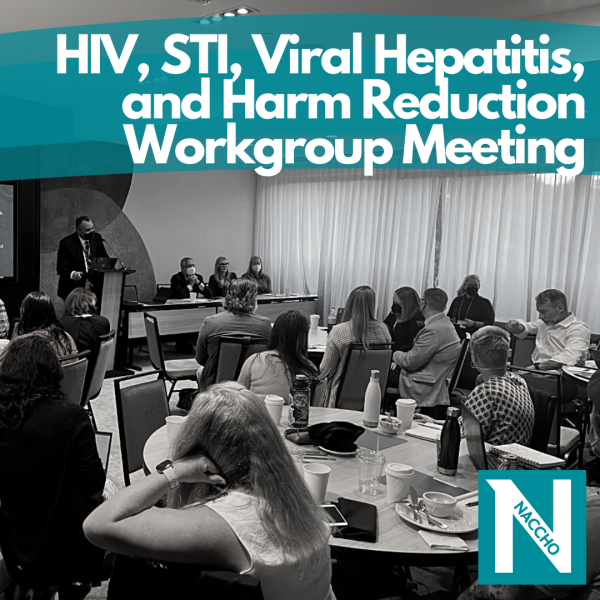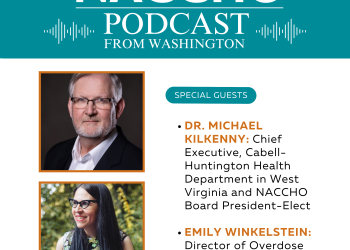In November, the HIV, STI, Viral Hepatitis, and Harm Reduction Workgroup (HSHW) met in person, with representatives from CDC to share LHD experiences in the HIV, STI, and Harm Reduction spaces, hear of CDC priorities, and strategize together on advancing program successes and addressing program challenges.
The meeting kicked off with a presentation from the Division of STD Prevention (DSTDP). There was a good deal of discussion around DSTDP’s efforts to promote integration and coordination as well as to strengthen the workforce. Members noted that the process for receiving federal funds can be burdensome, especially when attempting to coordinate with a fee-for-service funding model. We discussed whether it was possible to make funding streams work together to better support integrated public health services. Another key takeaway from this session was the challenge of properly staffing local health departments, as many jurisdictions are unable to offer competitive salaries. Further, outdated jurisdictional hiring policies may reinforce health inequities by disadvantaging applicants with lived or other relevant experience. Additionally, participants repeatedly mentioned the immediate and urgent need for national level staffing and training metrics and resources for DIS activities.
We then met with the Division of HIV Prevention (DHP). DHP described their four cross-cutting focus areas: health equity, a status neutral approach, community engagement, and a syndemic approach. NACCHO prioritizes work in these four areas as well. For a more detailed look into these focus areas, check out the PowerPoint linked above. During discussion, challenges of workforce, hiring, and retention came up once again, as did funding, as participants requested to hear more about funding opportunities available to the states with whom they work. From a programmatic perspective, participants asked for more guidance and support surrounding cluster detection response (CDR), noting that some states already have CDR response plans however many local health departments may not be aware of this resource altogether. As always, HIV related stigma continues to present programmatic challenges. Participants mentioned that communities should be included in messaging and communication around these topics.
Finally, we met with partners from the Division of Viral Hepatitis (DVH), Division of HIV Prevention (DHP) and the National Center for HIV, Viral Hepatitis, STD, and TB Prevention Office of the Director (NCHHSTP OD) to explore CDC’s cross cutting Harm Reduction response. NCHHSTP OD outlined four areas of strategic priority focus. The first area emphasized their priority of establishing nationwide infrastructure for SSPs as a standard of care. The next goal was to decrease drug injection use. The third area of focus was to establish coordinated surveillance and monitoring systems for infectious disease indicators associated with drug use. The fourth and final area of focus was to collaborate at the federal, state, and local levels to reduce infectious disease consequences of drug use. Funding was a primary theme throughout the entirety of the session, as in previous sessions. Participants wanted to know what efforts were being made to coordinate and consolidate funding for syringe services programs (SSPs). We also discussed policy, and participants voiced their desire for issue briefs and statements surrounding safer smoking, youth access, housing, communication, and funding needed to support state initiatives. Local health department representatives expressed difficulty with purchasing necessary supplies and materials for their programs. Once again, we addressed stigma within the community and amongst healthcare providers as an area of interest.
We returned after lunch to an inspiring session from Atlanta Harm Reduction Coalition led by Mojgan Zare, MD, MPH, CEO and Jasmine Benton, MA, Program Director. Zare discussed the menu of services that AHRC provides- from allowing community members to shower or make phone calls or have a homecooked meal for free to hiring people with lived experiences to help run their programs. AHRC runs a mobile STI testing van and, according to Zare, has created an admirable reputation in the community that they serve. Workgroup members were interested in learning about AHRC’s different funding sources that support their work. AHRC also mentioned a “whole person” model/approach in which they address the entirety of their community members rather than just one part of their identity. Workgroup members were interested in learning more about how they achieved this model and how it could potentially be replicated across local health departments. AHRC also discussed their relationship with law enforcement. Workgroup members asked how local health departments could play more of a role in those relationships, especially regarding syringe service programs.
We are so grateful that the CDC took time out of their busy schedules to meet with the workgroup and discuss pressing matters in the HIV, STI, Viral Hepatitis, and Harm Reduction realm. NACCHO continues to work with the HIV, STI, Viral Hepatitis, and Harm Reduction workgroup to discuss next steps that ensure follow-up on priorities that emerged from these conversations.



